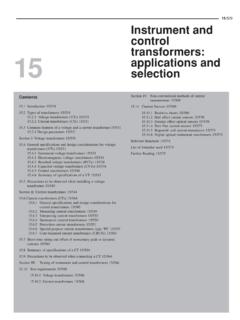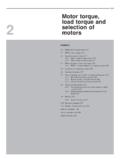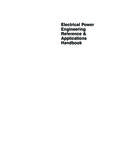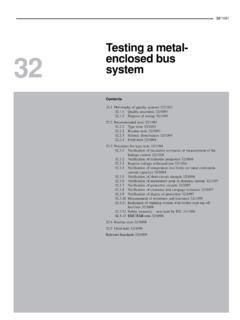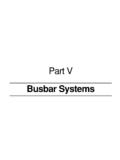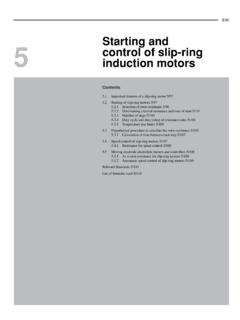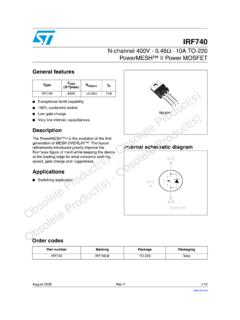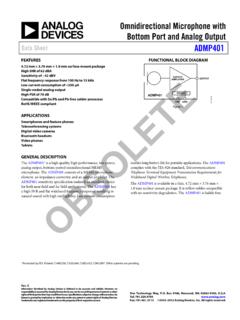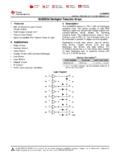Transcription of Contents
1 18/68118 Surge arresters:applications arresters 18 Gapped surge arresters 18 Gapless surge arresters 18 characteristics of a ZnO surge arrester 18 insulation level (BIL) 18 margins 18 Steepness (t1) of the FOW 18 Effect of discharge or co-ordinating current (In) onthe protective level of an arrester 18 Margin for contingencies 18 level of the a surge arrester 18 Reflection of the travelling waves 18 Surge transference through a transformer 18 Effect of resonance 18 of a gapless surge arrester 18 TOV capability and selection of rated voltage, Vr18 Selecting the protective level of the arrester 18 Required energy capability in kJ/kVr 18 of arresters 18 of distribution class surge arresters 18 relief facility 18 Assessing the condition of an arrester 18/710 Relevant Standards 18/718 List of formulae used 18/718 Further Reading 18/719 Surge arresters.
2 Applications and selection18 Surge arrestersWhen surge protection is considered necessary, surgearresters* may be installed on or near the equipmentbeing protected. This is a device that limits the high TVs(transient voltages) generated during a system disturbanceby diverting the excessive part of it to the ground andreducing the amplitude of the transient voltage waveacross the equipment to a permissible safe value lessthan the impulse withstand level of the equipment ( , , (a), , and ). The rate of rise oftransient voltage remains the same. A surge arrester doesnot tame the steepness of the surge, VtVtt11t21 = (curves oa1 and oa2 of Figure )thus shielding the connected equipment from dangerousvoltage surges. This is achieved by providing a conductingpath of relatively low surge impedance between the lineand the ground to the arriving surge.
3 The discharge currentto the ground through the surge impedance limits theresidual voltage across the arrester hence the equipmentand the system connected to it. During normal servicethis impedance is high enough to provide a near-opencircuit. It remains so until a surge voltage occurs and isrestored immediately after discharge of the excess arrester can be considered a replica of an HRC fuse. What afuse is to a fault current, arrester is to a voltage surge, both limit,their severity. While a fuse is a current limiting device and protectsthe connected equipment by limiting the prospective peak faultcurrents, Isc (Figure ), an arrester is a voltage limiting deviceand protects the connected equipment by limiting the prospectivepeak surge voltage, Vt (curve oa2, Figure ).
4 Arresters or diverters are generally of the followingtypes and the choice between them will depend upon thepower frequency system voltage, characteristics of thevoltage surges and the grounding system, (i) Gapped or conventional type, and(ii) Gapless or metal oxide Gapped surge arrestersThese are generally of the following types:1 ExpulsionThese interrupt the follow current by anexpulsion action and limit the amplitude of the surgevoltages to the required level. They have low residualsafe or discharge voltages (Vres). The arrester gap ishoused in a gas-ejecting chamber that expels gasesduring spark-over. The arc across the gap is quenchedand blown-off by the force of the gases thus enclosure is so designed that after blowing offthe arc it forcefully expels the gases into theatmosphere.
5 The discharge of gases affects thesurroundings, particularly nearby equipment. The gas-ejecting enclosure deteriorates with every operationand, therefore, has only a limited operating , these types of arresters are of specific ratingsand an excessive surge than the rated may result in itsfailure. They are now obsolete in view of their frequentfailures and erratic behaviour and the availability ofa more advanced technology in a metal oxide gapThese have a pair of conducting rodswith an adjustable gap, depending upon the spark-over-voltage of the arrester. Precise protection is notpossible, as the spark-over-voltage varies with polarity,steepness and the shape of the wave. These arrestersare also now obsolete for the same or non-linear resistorIn this version, anonlinear SiC resistance is provided across the gapand the whole system works like a preset valve forthe follow current.
6 The resistance has an extremelylow value on surge voltages and a very high one duringnormal operations to cause a near-open circuit. It isnow easier to interrupt the follow non-linear resistor-type gapped surge arrester maygenerally consist of three non-linear resistors (NR) inseries with the three spark gap assemblies ( (a)). The resistance decreases rapidly from a highvalue at low currents to a low value at high currents,such that RI constant (Figure (b)). Hence, V-I isan almost flat curve, as illustrated in Figure (b).Thyrite* and Metrosil* are such materials. The purposeof non-linear resistors is to permit power frequencyfollow currents, after the clearance of surge voltages,while maintaining a reasonably low protective level(Vres). Across the spark gaps, known as current limitinggaps, are provided high-value resistors (HR) backedup with HRC fuses.
7 The non-linear resistors have avery flat V-I curve, they maintain a near-constantvoltage at different discharge currents. The flatness ofthe curve provides a small residual voltage and a lowcurrent. When the switching or lightning surge voltageexceeds the breakdown voltage of the spark gap, aspark-over takes place and permits the current to flowthrough the non-linear resistor NR. Due to the non-linear characteristics of the resistor, the voltage acrossthe motor terminals (when protecting a motor) is limitedto approximately the discharge commencing voltage(Vres), which is significantly below the 3 5 levelfor a motor (Table )). It may be noted that the useof resistor across the spark gap stabilizes the breakdownof the spark gap by distributing the surge voltage betweenthe gap and the non-linear resistor.
8 Figures (a) and(b) are oscillograms illustrating the effect of a surgearrester in arresting the surge voltages caused during aswitching operation or a lightning current limiting gaps, as noted above, in series*Basically they are surge diverters but conventionally are calledarresters. Up to 245 kV lightning surges and beyond 245 kV switchingsurges are found to be more severe, Section It is customary,therefore, to call an arrester up to 245 kV a lightning arrester andbeyond 245 kV a surge arrester. For ease of reference, we havedescribed them as surge arresters or only arresters for all types.*Thyrite is a brand name from General Electric, is a brand name from a GEC company in the Electrical Power Engineering Reference & Applications Handbookwith the non-linear resistors make it possible to adjustthe protective level of the surge arrester for differentvalues of discharge currents.
9 They also help to maintaina near-constant voltage at around the switching surgeor lightning surge spark-over-voltages during the flowof surge currents while clearing a surge. For moredetails and testing see IEC Gapless surge arrestersFrom the above it is evident that material for non-linearresistance used in the manufacture of an efficient surgeprotection device must offer the least impedance duringa discharge. This is to provide a free flow to the excessivedischarge current to the ground, on the one hand, and todraw a negligible current under normal system conditions,to make it a low-loss device, on the other. The alternativewas found in ZnO. ZnO is a semiconductor device and isa ceramic resistor material constituting ZnO and oxidesof other metals, such as bismuth, cobalt, antimony andmanganese.
10 These ingredients in different proportionsare mixed in powdered form, ZnO being the mainingredient. It is then pressed to form into discs and firedat high temperatures to result in a dense polycrystallineceramic. The basic molecular structure is a matrix ofhighly conductive ZnO grains surrounded by resistiveintergranular layers of metal oxide elements. Underelectrical stress, the intergranular layers conduct and resultin a highly nonlinear characteristic. For example a changeof arrester current from 105 A to 1 A would result in avoltage change of only 54%. Since the content of ZnO issubstantial (around 90%) it is popularly known as a ZnOor metal oxide elements. Surge arresters made of theseelements have no conventional spark gap and call for nogap reseal and possess excellent energy absorptioncapability.
